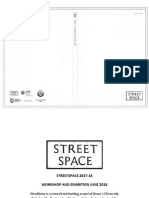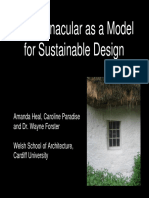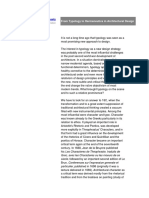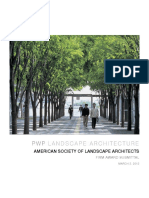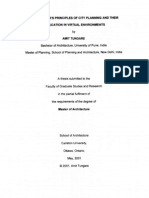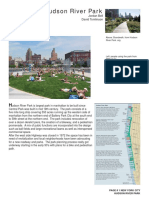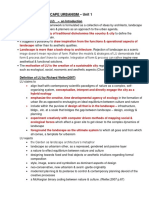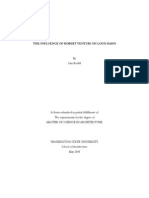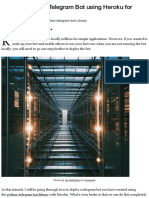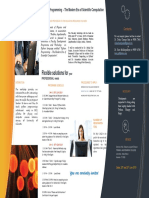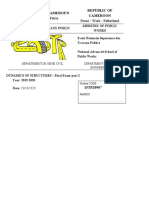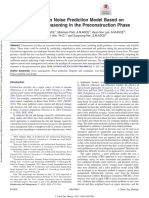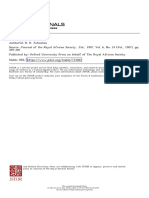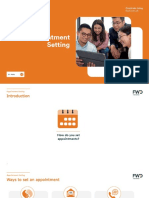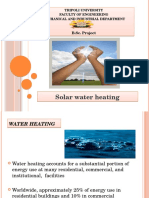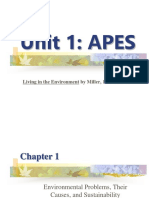2008 Gsd4401 Transparency Syllabus
2008 Gsd4401 Transparency Syllabus
Uploaded by
rajyamgarCopyright:
Available Formats
2008 Gsd4401 Transparency Syllabus
2008 Gsd4401 Transparency Syllabus
Uploaded by
rajyamgarOriginal Description:
Copyright
Available Formats
Share this document
Did you find this document useful?
Is this content inappropriate?
Copyright:
Available Formats
2008 Gsd4401 Transparency Syllabus
2008 Gsd4401 Transparency Syllabus
Uploaded by
rajyamgarCopyright:
Available Formats
GSD 4401 TRANSPARENCY Spring 2008 Instructor: Eve Blau Monday 2:00-5:00 517 Gund Hall Course Description
The concept of transparency is critical, not only to understanding early and mid-20th century modernism, but also to engaging current architectural concerns with mediation, density, surface, light, movement, and information. The purpose of the course is twofold: to recover the theoretical, ideological, and formal complexity of transparency in the discourses of modernism, and to explore the significance of the concept of transparency for architecture today. This exploration is founded on two working propositions: First that the discourse of transparency constitutes a kind of subtext of the discourses of modernism a text that continuously negotiates between the technological, aesthetic, social, and psychological dimensions of architecture. Second, that modes of representational discourse outside architecture film, photography, electronic and digital media have figured in important ways in the architectural conception of transparency. The first part of the course is concerned with the conceptualization of abstract space, in the early decades of the 20th century. This includes models of kinesthetic and haptic modes of perception and space formation around 1900 and the development in the 1920s and 1930s of an anti-perspectival conception of relational space or space-time by architects, artists, and theorists associated with the Bauhaus (van Doesburg, MoholyNagy, Gropius, Giedion, etc.); by experimental cimematographers (Hans Richter, in particular); as well as Le Corbusiers plans libres (or free plans) and the betonte Leere (or heightened emptiness) of Miess interiors in the late 20s. The Second part of the course will examine the art/science of camouflage, theories of pattern recognition, as well as Rowe and Slutzkys seminal articles (in Perspecta, 1963, 1971) on phenomenal transparency and their impact on design and architectural education in the 1960s and 70s: Peter Eisenman and the New York Five as well as connections to media studies (Marshall McLuhan) and object art in the 1960s. The course ends with the conception of transparency in the 1990s and 2000s what Terry Riley called light construction (1995) and others have characterized as manifestations of dematerialization and diffusion, of deep surface, of environment become information. Prerequisites: GSD 4201-4206 or equivalent or post-professional-degree status [MArch 2, MDesS, etc] Requirements/assignments: Course requirements include weekly readings and informed participation in class discussions. A careful preparation of the assigned reading for each week is expected of everyone. Throughout the semester students will be responsible for initiating discussion of selected weekly readings or topics relating to the
readings. The principal assignment is a 10 page research paper on a topic chosen by you in consultation with me. [Abstract due April 21; paper due May 16]
Syllabus and Reading: (schedule subject to change) 2/04 2/11 Introduction: Concerns, problematics, methods, structure of the course; assignments; schedule Shifting Eyes, Moving Bodies: Spatial Paradigms at the Turn of the 20th Century Reading: Adolf Hildebrand, Visual and Kinaesthetic Ideas, Form and Effect, The Idea Of Space and its Expression in the Appearance, The Problem of Form in the Fine Arts, in H.F.Mallgrave and E. Ikonomou (eds) Empathy, Form, and Space (Santa Monica: Getty Center, 1994): pp. 229-243. August Schmarzow, The Essence of Architectural Creation, in H.F. Mallgrave and E. Ikonomou (eds) Empathy, Form, and Space (Santa Monica: Getty Center, 1994): pp. 281-296. Camillo Sitte, City Planning According to Artistic Principles (1889) in Collins and Collins, Camillo Sitte: The Birth of Modern City Planning (NY: Rizzoli, 1986), pp. 243-250, 271-278. 2/18 2/25 [PRESIDENTS DAY: NO CLASS] Abstract Space, Figured Ground: Stereography, Cubism, De Stijl Reading: Jonathan Crary, Techniques of the Observer (MIT Press, 1990), pp. 97-150. Rosalind Krauss, Analytic Space: futurism and constructivism, Passages in Modern Sculpture (The MIT Press, 1981), pp. 39-67. Yve-Alain Bois, Metamorphosis of Axonometry, Daidalos #1 (1981), pp. 40-59. Also Recommended: Yve-Alain Bois, Kahnweilers Lesson, in Painting as Model (The MIT Press, 1990), pp.65-97. 3/03 Museum Visit: Busch-Reisinger [Bauhaus Collection] Reading: Rosalind Krauss, Grids, The Originality of the Avant-Garde and Other Modernist Myths (The MIT Press, 1986), pp. 8-22. Yve-Alain Bois, The De Stijl Idea, Painting as Model (The MIT Press, 1990):
101-122. 3/10 Space-Time: Giedion, Moholy-Nagy, and the Bauhaus Reading: Sigfried Giedion, Building in France, Building in Iron, Building in FerroConcrete (1928) reprint (Santa Monica: Getty Center, 1995): 85-93, illustrations and captions throughout the book. Sigfried Giedion, Space Time and Architecture (1941) Sixth printing. (Harvard U. Press, 1976): 491-496. Laszlo Moholy-Nagy, Space, The New Vision (1929), reprinted (NY: Wittenborn, 1947): 55-64, 77-85. Also recommended: Sergei M. Eisenstein, Montage and Architecture, including Introduction by Yve- Alain Bois, Assemblage 10 (December 1989): 111-131. Detlef Mertins, Transparency:Autonomy & Relationality AAFiles 32 (1996):3-11. 3/17 The Film Thickened Moment: Richter, Le Corbusier, Mies and the Remembering Eye Reading: Eve Blau, Transparency and the Irreconcilable Contradictions of Modernity, PRAXIS 9 (fall 2007): 50-59 Bruno Reichlin, Jeanneret-Le Corbusier, Painter-Architect, in Eve Blau and Nancy Troy (eds) Architecture and Cubism (MIT, 1997): 195-218. Robin Evans, Mies van der Rohes Paradoxical Symmetries, Translations from Drawing to Building (London: AA, 1997): 233-276. Hans Richter, The Badly Trained Sensibility in P.Adams Sitney (ed) The Avant-Garde Film (NYU Press, 1978), pp. 22-23. 3/24 3/31 [SPRING BREAK: NO CLASS] The Aerial Perspective: Camouflage + Pattern Recognition Reading: Roy R. Behrens, Camouflage, Art and Gestalt, Art & Camouflage: Concealment and Deception in Nature, Art, and War. (Cedar Falls: Univ of Northern Iowa, 1982): 9-20 Gyorgy Kepes, The three dimensional field, The spatial forces, Fields of spatial forces Language of Vision (Dover, 1944), pp. 19-29. Marshall McLuhan, The Invisible Environment: The Future of Erosion, Perspecta 11 (1967): 162-167.
Also recommended: Marshall McLuhan, The Medium is the Message, Understanding Media (NY: The New American Library, 1967): 23-35. 4/07 Rowe and Slutzky + Phenomenal Transparency: The Birth of a Paradigm Reading: Colin Rowe and Robert Slutzky, Transparency: Literal and Phenomenal, Perspecta 8 (1963): 45-54. [reprinted in Todd Gannon, editor, The Light Construction Reader (NY: Monacelli, 2002), pp. 91-101.] Rowe and Slutzky, Transparency: Literal and Phenomenal. Part 2, Perspecta 13/14 (1971): 286-301. [repr. Light Construction Reader, pp.103-113.] Rosalind Krauss, Death of a Hermaneutic Phantom: Materialization of the Sign in the Work of Peter Eisenman, in Eisenman, Houses of Cards (Oxford U. Press, 1987), pp. [repr. Light Construction Reader, pp.157-169.] Jeffrey Kipnis, P-trs Progress, (1996), [repr. Light Construction Reader, pp. 147-155.] Also Recommended: Bernard Hoesli, Transparency Instrument of Design, in Colin Rowe and Robert Slutzky, Transparency (Basel: Birkhuser, 1997), pp. 97-119. 4/14 Light Construction Reading: Anthony Vidler, Transparency, The Architectural Uncanny (1992), [repr. Light Construction Reader, pp.267-273]] Terence Riley, Light Construction Light Construction (MoMA,1995), pp. 9-32. Alejandro Zaera, Herzog and de Meuron: Between the Face and the Landscape, El Croquis 60 (1993): 24-36 Hans Ibelings, Supermodernism: Architecture in the Age of Globalization (Rotterdam: NAI Publishers, 2002): 55-127 4/21 Transparency Today [Paper Abstracts due] Reading: Alejandro Zaera, A Conversation with Kazuyo Sejima and Ryue Nishizawa, El Croqius: Kazuyo Sejima + Ryue Nishizawa 1995-2000 (2000): 8-20 Ben Van Berkel, Afterimage, UN Studio Design Models: Architecture, Urbanism, Infrastructure (London: Thames and Hudson, 2006): 370-379. Michael Speaks, Intelligence After Theory, Perspecta 38 (2006): 103-107. 4/28 Individual Meetings re. Papers
You might also like
- Final Project CharterDocument5 pagesFinal Project Charterapi-359730461100% (2)
- AIR-CL-CER-RSC-540 R.00 - Checklist For TCAR Part 145 Repair Station AuditDocument22 pagesAIR-CL-CER-RSC-540 R.00 - Checklist For TCAR Part 145 Repair Station AuditAnusorn sinNo ratings yet
- The Lessons of Rome Jon Michael SchwartingDocument26 pagesThe Lessons of Rome Jon Michael SchwartingPaul TurnerNo ratings yet
- Universal Design PrinciplesDocument3 pagesUniversal Design PrinciplesRob PearsonNo ratings yet
- Unit 1 - Modern Archiecture-Spread and Later DirectionsDocument161 pagesUnit 1 - Modern Archiecture-Spread and Later DirectionsMdNo ratings yet
- Curriculum Vitae Charles WaldheimDocument6 pagesCurriculum Vitae Charles WaldheimlulugovindaNo ratings yet
- Shadrach Woods and The Architecture of Everyday UrbanismDocument40 pagesShadrach Woods and The Architecture of Everyday UrbanismAngemar Roquero MirasolNo ratings yet
- The Child in The City: Colin WardDocument18 pagesThe Child in The City: Colin Wardpallavimagic1No ratings yet
- New Lynn Urban Regeneration FrameworkDocument6 pagesNew Lynn Urban Regeneration FrameworkfcharafNo ratings yet
- Lavin Temporary ContemporaryDocument9 pagesLavin Temporary Contemporaryshumispace3190% (1)
- Complete Streetspace Publication 2018-SmallDocument41 pagesComplete Streetspace Publication 2018-SmallAgustina Martire UrquijoNo ratings yet
- Neuro-Associative Conditioning: Programing Your Trading Mind'Document21 pagesNeuro-Associative Conditioning: Programing Your Trading Mind'ediNo ratings yet
- Design Optimisation of Space Frame ChassisDocument40 pagesDesign Optimisation of Space Frame Chassisadj adj100% (1)
- GSD 2241 Planting Systems Lecture Michael Flynn XuevxiDocument159 pagesGSD 2241 Planting Systems Lecture Michael Flynn XuevxiJohn Mark CarpioNo ratings yet
- Vol14 Stephen PoonDocument24 pagesVol14 Stephen PoonZâïñåb Hïñä IrfâñNo ratings yet
- The Accidental Playground: Brooklyn Waterfront Narratives of the Undesigned and UnplannedFrom EverandThe Accidental Playground: Brooklyn Waterfront Narratives of the Undesigned and UnplannedNo ratings yet
- ARQ - Early Venturi, Rauch & Scott BrownDocument10 pagesARQ - Early Venturi, Rauch & Scott BrownJohn JohnsonNo ratings yet
- The Landscape Urbanism Reader, Charles WaldheimDocument2 pagesThe Landscape Urbanism Reader, Charles WaldheimTharindu WeerasingheNo ratings yet
- 896 Heal PDFDocument15 pages896 Heal PDFCHAITALI BABARNo ratings yet
- A Study of The Principles of The Ideal Urban-Architecture For The 21st CenturyDocument270 pagesA Study of The Principles of The Ideal Urban-Architecture For The 21st CenturyEspoirNoirNo ratings yet
- Transcultural Architecture The Limits and Opportunities of Critical Regionalism 9781472463425 1472463420Document221 pagesTranscultural Architecture The Limits and Opportunities of Critical Regionalism 9781472463425 1472463420HanNo ratings yet
- Anyone For Urban Acupuncture?Document1 pageAnyone For Urban Acupuncture?Julian DobsonNo ratings yet
- Rem Koolhaas Bigness or The Problem of LargeDocument4 pagesRem Koolhaas Bigness or The Problem of LargeIrem UsluNo ratings yet
- 1-2 Regionalism and Identity PDFDocument36 pages1-2 Regionalism and Identity PDFOmar BadrNo ratings yet
- Housing For EuropeDocument228 pagesHousing For EuropeLea MiokovićNo ratings yet
- HM Proceedings Final LightDocument514 pagesHM Proceedings Final LightnNo ratings yet
- Charles Waldheim: EducationDocument21 pagesCharles Waldheim: EducationWowkieNo ratings yet
- When A Patio Becomes A City: (In) Volution of Carrières Centrales, Casablanca (1953 - 2018)Document20 pagesWhen A Patio Becomes A City: (In) Volution of Carrières Centrales, Casablanca (1953 - 2018)meriam rondiNo ratings yet
- Reyner Banham - A Throw-Away AestheticDocument4 pagesReyner Banham - A Throw-Away AestheticclaudiotriasNo ratings yet
- Julian Varas - in The Name of The User PHD Diss - PUC - June - 2017 PDFDocument373 pagesJulian Varas - in The Name of The User PHD Diss - PUC - June - 2017 PDFJairMartinezNo ratings yet
- Urban Village TheoryDocument17 pagesUrban Village TheoryNadhirah Agasshi0% (1)
- The - New - New Brutalism by Michael JDocument6 pagesThe - New - New Brutalism by Michael JSomeonealreadygotthatusername.No ratings yet
- ARC251 02the Scope of Urban DesignDocument9 pagesARC251 02the Scope of Urban Designcurve foldingNo ratings yet
- Transitional Design HistoriesDocument177 pagesTransitional Design HistoriesPaula OchoaNo ratings yet
- Chasse Park Appartments - Breda (The Netherlands) - DEGEYTER2001Document1 pageChasse Park Appartments - Breda (The Netherlands) - DEGEYTER2001susCitiesNo ratings yet
- Jaime Correa PDFDocument4 pagesJaime Correa PDFmisanthropoNo ratings yet
- Urban Design Manifesto by Jacobs 1987Document9 pagesUrban Design Manifesto by Jacobs 1987NivedhithaVenkatakrishnanNo ratings yet
- Beijing Catalogue ArchitectsDocument200 pagesBeijing Catalogue Architectsalexxa_popescuNo ratings yet
- From Typology To Hermeneutics in Architectural DesignDocument15 pagesFrom Typology To Hermeneutics in Architectural DesignOrangejoeNo ratings yet
- Preserving Postmodern ArchitectureDocument123 pagesPreserving Postmodern ArchitectureakhilaNo ratings yet
- PWP LandscapeDocument29 pagesPWP LandscapeAnthony GeorgeNo ratings yet
- Le CorbusierDocument176 pagesLe CorbusierChania BhatiaNo ratings yet
- Christopher Alexander-Titles 24ptDocument23 pagesChristopher Alexander-Titles 24ptNick Vella Muskat100% (1)
- Chapter 9 Slums AssignmentDocument4 pagesChapter 9 Slums AssignmentMuhammad AwanNo ratings yet
- Hudson River Park: Jordan Bell David TomlinsonDocument13 pagesHudson River Park: Jordan Bell David TomlinsonInduShajiNo ratings yet
- Art or BunkDocument81 pagesArt or BunkIan GroundNo ratings yet
- Waldheim - Notes Toward A History of Agrarian UrbanismDocument7 pagesWaldheim - Notes Toward A History of Agrarian Urbanismadrip01No ratings yet
- Review John Friedman and HealeyDocument7 pagesReview John Friedman and HealeyMartein AdiganaNo ratings yet
- 4 TownscapeDocument21 pages4 Townscapefrajo100% (2)
- Unit 1 - Sustainable Landscape UrbanismDocument18 pagesUnit 1 - Sustainable Landscape UrbanismvishalakshiNo ratings yet
- Ankone, Joost 1Document120 pagesAnkone, Joost 1Sidra JaveedNo ratings yet
- Tactical Urbanism: Ephemeral Solutions Permanent ChangeDocument1 pageTactical Urbanism: Ephemeral Solutions Permanent ChangeAlisha Khan100% (1)
- PhD-thesis-antonio Lopes CorreiaDocument527 pagesPhD-thesis-antonio Lopes CorreiaCamilo churio0% (1)
- The Role of Public Space in Urban LIfeDocument19 pagesThe Role of Public Space in Urban LIfeDenny Nidus-masNo ratings yet
- Urban Design Compendium Complete PDFDocument230 pagesUrban Design Compendium Complete PDFAgnes Cheverloo CastilloNo ratings yet
- Urban History: Grigor DoytchinovDocument43 pagesUrban History: Grigor DoytchinovRamona CasianNo ratings yet
- W3 Lecture - Theories Related To Community PlanningDocument12 pagesW3 Lecture - Theories Related To Community PlanningEricka MayNo ratings yet
- Saverio Muratori Towards A Morphological School of Urban DesignDocument14 pagesSaverio Muratori Towards A Morphological School of Urban Design11No ratings yet
- The Influence of Robert Venturi On Louis KahnDocument108 pagesThe Influence of Robert Venturi On Louis KahnLira Kulla100% (1)
- Contested Urbanism in DharaviDocument156 pagesContested Urbanism in DharaviarauuuNo ratings yet
- Gender and Urban SpaceDocument18 pagesGender and Urban SpaceLucasNo ratings yet
- The Rite of Urban Passage: The Spatial Ritualization of Iranian Urban TransformationFrom EverandThe Rite of Urban Passage: The Spatial Ritualization of Iranian Urban TransformationNo ratings yet
- A Complete Guide Using The Python-Telegram-Bot Library: May 4, 2020 6 Min ReadDocument11 pagesA Complete Guide Using The Python-Telegram-Bot Library: May 4, 2020 6 Min ReadrajyamgarNo ratings yet
- National Urban Digital Mission Fellowship Program 2022: A Compendium of InsightsDocument82 pagesNational Urban Digital Mission Fellowship Program 2022: A Compendium of InsightsrajyamgarNo ratings yet
- Improper Medical Waste Management in Most Hospital and IndustriesDocument5 pagesImproper Medical Waste Management in Most Hospital and IndustriesrajyamgarNo ratings yet
- Internship PosterDocument1 pageInternship PosterrajyamgarNo ratings yet
- Urban Administration and Development - District Hoshangabad, Government of Madhya Pradesh - IndiaDocument2 pagesUrban Administration and Development - District Hoshangabad, Government of Madhya Pradesh - IndiarajyamgarNo ratings yet
- Smart Water Quality Monitoring System Based On Iot: Journal Critical ReviewsDocument6 pagesSmart Water Quality Monitoring System Based On Iot: Journal Critical ReviewsrajyamgarNo ratings yet
- Electives 2020Document17 pagesElectives 2020rajyamgarNo ratings yet
- Pages From Shimokawa SDGsReport JP 0713 0Document2 pagesPages From Shimokawa SDGsReport JP 0713 0rajyamgarNo ratings yet
- Pages From RFP For Integrated Solid Waste ManagementDocument2 pagesPages From RFP For Integrated Solid Waste ManagementrajyamgarNo ratings yet
- (First Name) (Surname) : ExperienceDocument1 page(First Name) (Surname) : ExperiencerajyamgarNo ratings yet
- Infrastructure Planning (MIP) M.sc. - Study Program - University of StuttgartDocument5 pagesInfrastructure Planning (MIP) M.sc. - Study Program - University of StuttgartrajyamgarNo ratings yet
- The Sustainable Managementofa Tourism Destinationin Ireland AFocuson County ClareDocument27 pagesThe Sustainable Managementofa Tourism Destinationin Ireland AFocuson County ClarerajyamgarNo ratings yet
- Mars - Ideas Competition For Klaf2019Document7 pagesMars - Ideas Competition For Klaf2019rajyamgarNo ratings yet
- High EngDocument4 pagesHigh EngrajyamgarNo ratings yet
- Corrige ND Um 21122018Document1 pageCorrige ND Um 21122018rajyamgarNo ratings yet
- Origyn Brief2Document15 pagesOrigyn Brief2rajyamgarNo ratings yet
- Code 19 J Sub 2018 Feature Film Screenplay Writing Part 2Document28 pagesCode 19 J Sub 2018 Feature Film Screenplay Writing Part 2rajyamgarNo ratings yet
- sm1 111210001159 Phpapp01Document3 pagessm1 111210001159 Phpapp01rajyamgarNo ratings yet
- It Is A Mini ProjectDocument34 pagesIt Is A Mini ProjectMohit DixitNo ratings yet
- Flexible Solutions For: You Are Cordially InvitedDocument1 pageFlexible Solutions For: You Are Cordially InvitedSomu MaitiNo ratings yet
- Grade 1 Curriculum Map (All Subjects)Document101 pagesGrade 1 Curriculum Map (All Subjects)EVANGELINE MALABANANNo ratings yet
- Republique Du Cameroun Paix - Travail - Patrie Republic of Cameroon Peace - Work - FatherlandDocument32 pagesRepublique Du Cameroun Paix - Travail - Patrie Republic of Cameroon Peace - Work - FatherlandGuillaume Hervé POH'SIÉNo ratings yet
- RECESSIONDocument3 pagesRECESSIONFhatma Warda Bin't MantolinoNo ratings yet
- Noise Prediction ModelDocument12 pagesNoise Prediction ModelNivedita JhaNo ratings yet
- Origin of The BantusDocument13 pagesOrigin of The BantusBoss CKNo ratings yet
- Kapra Trial Pit ReportDocument7 pagesKapra Trial Pit Reportbrahmanna penumakaNo ratings yet
- Anotasi Bibliografi Teori Pendidikan KewarganegaraanDocument3 pagesAnotasi Bibliografi Teori Pendidikan KewarganegaraanIsmailPartIINo ratings yet
- Delegate Confirmation LetterDocument2 pagesDelegate Confirmation LetterBLK AssalamNo ratings yet
- Filipino Concept of "Loob": Christine Carmela R. Ramos, PH.DDocument5 pagesFilipino Concept of "Loob": Christine Carmela R. Ramos, PH.DMichel NayreNo ratings yet
- 34 Cursos de Coaching e PNLDocument4 pages34 Cursos de Coaching e PNLRaphael Jacob Moura50% (2)
- Appointment Setting ModuleDocument29 pagesAppointment Setting Moduleliezl12345No ratings yet
- Maritime Delimitation in The Black Sea Romania v. UkraineDocument7 pagesMaritime Delimitation in The Black Sea Romania v. UkraineMargreth MontejoNo ratings yet
- Porque Michel Houellebecq Esta Errado AcDocument7 pagesPorque Michel Houellebecq Esta Errado AcHaxan xNo ratings yet
- المشروع PresentationDocument48 pagesالمشروع PresentationFaraj AlferjaniNo ratings yet
- CH 4 Test Review QuestionsDocument17 pagesCH 4 Test Review QuestionsHoàng LongNo ratings yet
- Introduction To Chromatography: ComponentsDocument24 pagesIntroduction To Chromatography: ComponentsprabhatNo ratings yet
- Forcepoint: Data Loss Prevention (DLP)Document6 pagesForcepoint: Data Loss Prevention (DLP)acamposbrNo ratings yet
- Buffalo Milk CheeseDocument6 pagesBuffalo Milk CheeseAsif MerajNo ratings yet
- Community Participation: Concept PaperDocument5 pagesCommunity Participation: Concept PaperShahidul Islam ChowdhuryNo ratings yet
- El103 - Module 2Document6 pagesEl103 - Module 2Mark Kaven LazaroNo ratings yet
- Unit 1: APES: Living in The Environment by Miller, 16 EditionDocument71 pagesUnit 1: APES: Living in The Environment by Miller, 16 EditionGrasielly CostaNo ratings yet
- Free Tutorial For - Me Tutorial For Electronic Devices Cicuits by U.a.bakshiDocument3 pagesFree Tutorial For - Me Tutorial For Electronic Devices Cicuits by U.a.bakshidaood abdullah0% (1)
- Molecular Dynamics - Basics - QuantumATK P-2019.03 DocumentationDocument14 pagesMolecular Dynamics - Basics - QuantumATK P-2019.03 DocumentationrainydaesNo ratings yet










